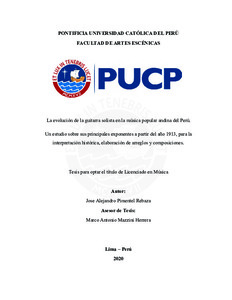| dc.contributor.advisor | Mazzini Herrera, Marco Antonio | |
| dc.contributor.author | Pimentel Rebaza, Jose Alejandro | |
| dc.date.accessioned | 2021-01-18T21:27:22Z | |
| dc.date.available | 2021-01-18T21:27:22Z | |
| dc.date.created | 2020 | |
| dc.date.issued | 2021-01-18 | es_ES |
| dc.identifier.uri | http://hdl.handle.net/20.500.12404/17869 | |
| dc.description.abstract | Las investigaciones orientadas a describir la trayectoria de la guitarra solista como
instrumento clave en la interpretación de la música popular, específicamente la música
andina en el Perú ha sido muy limitada. En gran parte, los estudios realizados sobre este
instrumento no han superado la formalidad de la transcripción de los arreglos más
representativos de los autores o intérpretes más famosos. Debido a ello, nace en el
investigador el interés en elaborar un estudio sobre la evolución de la guitarra solista en la
música popular andina del Perú, a partir del análisis de sus principales exponentes, lo que
implica su interpretación histórica, elaboración de arreglos y composiciones, desde la
perspectiva de una investigación para las artes escénicas. Bajo esta premisa, los propósitos
de estudio de la presente investigación son, en primera instancia, definir y explicar el
concepto de guitarra solista a y su relación con las principales formas musicales de la música
popular andina del Perú. Luego, se hizo una relación histórica acerca de la evolución de la
guitarra solista en la música popular andina en el Perú, desde la perspectiva metodológica
de la investigación para las artes de Borgdorff (2005), que consiste en la referenciación del
proceso creativo y el resultado artístico de una selección en forma cronológica de los
principales representantes del género, guitarristas cuyos estilos personales han hecho escuela
en la historia de la guitarra solista de la música popular en el país: Alejandro Gómez Morón,
Alberto Juscamaita, Gaspar Andía Fajardo, Raúl García Zárate, Pablo Ojeda Vizcarra,
Daniel Kirwayo, Manuel Prado Alarcón, Riber Oré y Rolando Carrasco Segovia. Además,
se procedió a la elaboración de dos arreglos propios para la guitarra solista a partir de los
resultados de esta investigación. Finalmente, se comparó los resultados de los arreglos
propios con el del análisis realizado anteriormente, al mismo tiempo en que se conoce a
profundidad los estilos personales de los guitarristas mencionados para realizar una
interpretación en la que se resuma el legado artístico de estos intérpretes y sus aportes a la
cultura musical peruana. | es_ES |
| dc.description.abstract | Research aimed at describing the trajectory of the solo guitar as a key instrument in
the interpretation of popular music, specifically Andean music in Peru, has been very
limited. In large part, the studies carried out on this instrument have not exceeded the
formality of the transcription of the most representative arrangements of the most famous
authors or interpreters. Due to this, the researcher's interest is born in developing a study on
the evolution of the solo guitar in Andean popular music in Peru, based on the analysis of its
main exponents, which implies its historical interpretation, elaboration of arrangements and
compositions, from the perspective of a research for the performing arts. Under this premise,
the purposes of the study of this research are, in the first instance, to define and explain the
concept of solo guitar through a general description of the different roles of instruments in
the main musical forms of popular music in Peru. Then, a historical relationship was made
about the evolution of the solo guitar in Andean folk music in Peru, from the methodological
perspective of research for the arts of Borgdorff (2005), which consists of the referencing of
the creative process and the artistic result of a chronological selection of the main
representatives of the genre, guitarists whose personal styles have made school in the history
of the solo guitar of popular music in the country: Alejandro Gómez Morón, Alberto
Juscamaita, Gaspar Andía Fajardo, Raúl García Zárate, Pablo Ojeda Vizcarra, Daniel
Kirwayo, Manuel Prado Alarcón, Riber Oré and Rolando Carrasco Segovia. In addition, we
proceeded to develop two own arrangements for the solo guitar, based on the results of this
research, to be interpreted in a concert of qualification. Finally, the results of the two
arrangements were compared with that of the analysis performed previously, at the same
time that the personal styles of the mentioned guitarists are known in depth to perform an
interpretation that summarizes the artistic legacy of these performers and their contributions
to the Peruvian musical culture. | es_ES |
| dc.language.iso | spa | es_ES |
| dc.publisher | Pontificia Universidad Católica del Perú | es_ES |
| dc.rights | info:eu-repo/semantics/closedAccess | es_ES |
| dc.subject | Música para guitarra--Perú--Andes, Región | es_ES |
| dc.subject | Música popular--Perú | es_ES |
| dc.subject | Guitarra--Estudio y enseñanza | es_ES |
| dc.title | La evolución de la guitarra solista en la música popular andina del Perú. Un estudio sobre sus principales exponentes a partir del año 1913, para la interpretación histórica, elaboración de arreglos y composiciones. | es_ES |
| dc.type | info:eu-repo/semantics/bachelorThesis | es_ES |
| thesis.degree.name | Licenciado en Música | es_ES |
| thesis.degree.level | Título Profesional | es_ES |
| thesis.degree.grantor | Pontificia Universidad Católica del Perú. Facultad de Artes Escénicas | es_ES |
| thesis.degree.discipline | Música | es_ES |
| renati.advisor.dni | 09599456 | |
| renati.advisor.orcid | https://orcid.org/0000-0003-4403-1741 | es_ES |
| renati.author.dni | 70330713 | |
| renati.discipline | 215426 | es_ES |
| renati.juror | Romero Cevallos, Raúl Renato | es_ES |
| renati.juror | Gastelumendi Fernández Concha, Mónica María | es_ES |
| renati.juror | Tello Malpartida, Aurelio Efraín | es_ES |
| renati.level | https://purl.org/pe-repo/renati/level#tituloProfesional | es_ES |
| renati.type | http://purl.org/pe-repo/renati/type#tesis | es_ES |
| dc.publisher.country | PE | es_ES |
| dc.subject.ocde | http://purl.org/pe-repo/ocde/ford#6.04.04 | es_ES |





